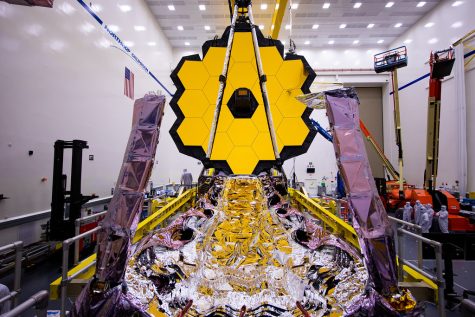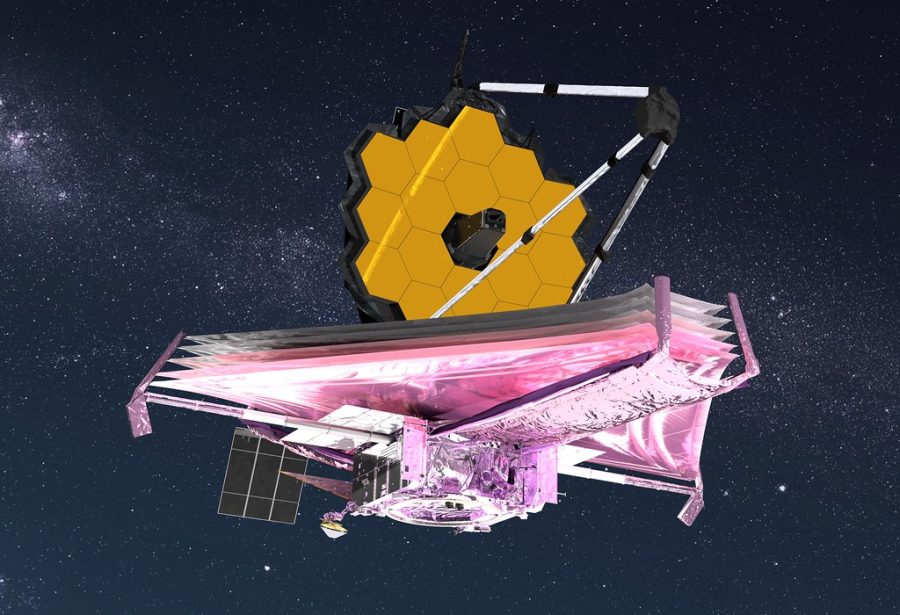James Webb Space Telescope ; A Gateway to the Cosmos
A CG image of the JWST after successful deployment. The telescope is expected to give scientists an unprecedented look at the cosmos.
January 21, 2022
With $9.7 billion dollars spent over a span of 24 years, the next generation of astronomy is here with NASA’s James Webb Space Telescope.
The James Webb Space Telescope had been under development since 1996 and was supposed to launch in 2007, but with funding issues, a stop was put to the program, and in 2005, a major redesign took place.
James Webb Telescope, the famous Hubble telescope’s successor, is 100 times more powerful than Hubble and will be able to see back in history about 250 million years after the Big Bang according to nasa.gov.
JWST will make leaps and bounds in astronomy and astrophysics. For example, JWST will be able to see into dust clouds where new stars are being born with high resolution. It will study early galaxies and the formation of solar systems with planets potentially like our home, Earth.
But JWST will also look inside our solar system. It will study things like Mars, Pluto, asteroids, comets, and other Kuiper Belt objects.
James Webb Space Telescope is equipped with 18 small golden mirrors that combine to make a 21-foot 4-inch one. This mirror is responsible for reflecting infrared light.
Furthermore, the telescope has a sun-shield, solar panels, small rocket engines, and much more. The sun-shield has 5 layers. The first only being .05 mm thick and the rest .025 mm. This kite-shaped shield protects the telescope from getting too hot since the temperature in space drastically changes depending on if it is in the shade or sunlight.

Because of the telescope’s massive size, it needed to unfold itself in space. It needed to deploy its tennis-court size sun shield, unfold its 18 hexagonal mirrors, and much more. Hundreds of mechanisms had to be successful for the telescope to unfold correctly.
Just weeks after launch, with much anticipation, James Webb Space Telescope has finished the meticulous task of unfolding without any issues. Now, JWST will spend its next 5 months calibrating and making sure its systems are working correctly in preparation for its operational lifetime.
The telescope launched from Guinea Space Center on December 25, 2021, atop the European Space Agency’s Ariane 5 rocket. Ariane 5 is a heavy-lift launch vehicle that has launched 111 times and is over 95 percent successful.
Thanks to an extremely accurate launch, the telescope will have enough fuel for close to 20 years of operations prior to the originally expected 10 years. Unlike Hubble, JWST will not orbit the Earth and therefore, cannot be serviced. JWST orbits the Sun in a place called the second Lagrange point according to nasa.gov.
The successful launch of the JWST represents another huge stride in expanding humanity’s understanding of the universe.













Carol Brosnahan • Jan 22, 2022 at 4:03 pm
What a success story. Just imagine being able to look back millions of years and learn how the Big Bang sent everything flying!
Norris Myers • Jan 22, 2022 at 3:39 pm
JWST seems to be an amazing accomplishment!!! It is exciting to think that it will be sharing scientific information for so many years.